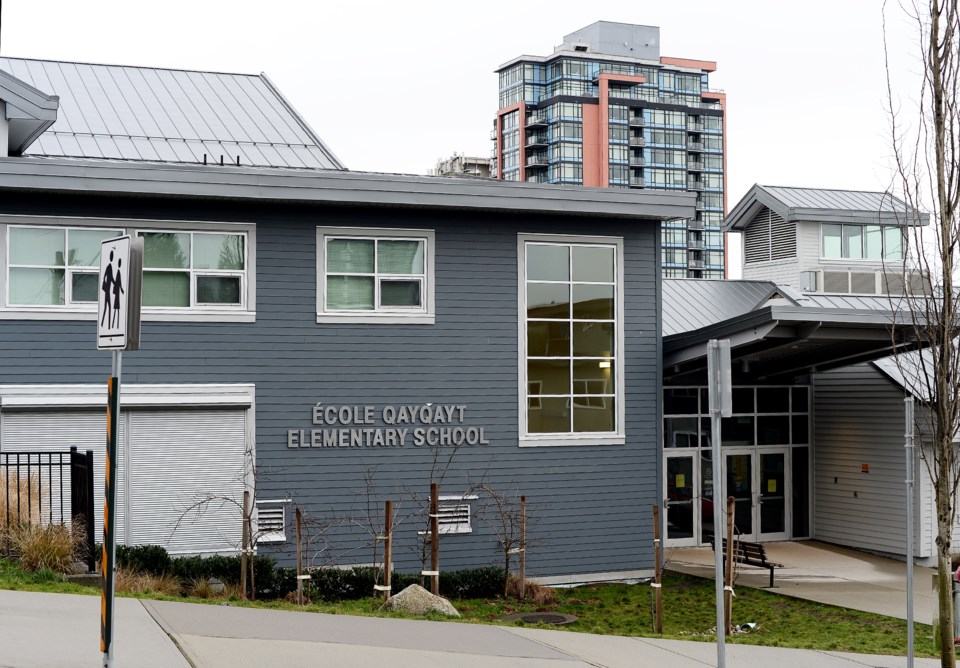Families with children entering kindergarten at New Westminster schools could find themselves facing a lottery for space in future years — especially if they live in the centre of the city.
The New Westminster school district is looking at ways to cope with capacity challenges at its elementary schools over the next few years, while it awaits funding for and construction of a new elementary school in the Fraser River zone (the central and western half of the city).
Secretary-treasurer Bettina Ketcham noted that, while the provincial government has acknowledged the need for a new elementary school, the project is currently at the business case stage — which puts it at least five years away from actual completion.
“We’re entering a very critical time,” she said at the June 21 school board meeting.
Ketcham noted the space crunch is particularly acute in the central part of the city, where École Qayqayt Elementary School, in the downtown, and Lord Kelvin Elementary School, next to Moody Park, are both full. Neither school is big enough to accommodate more enrolment growth.
For the coming 2022/23 school year, the district has already had to redirect 24 students in the Qayqayt catchment to other schools because there was no space for them at Qayqayt. A report to the board notes the problem will only become greater at both Qayqayt and Kelvin, and as many as 100 students could be affected in future years.
Registration opens in November and closes in January for the school year starting the following September, so any future changes will affect students starting school in 2023/24.
Lottery system or first-come, first-served? Trustees divided
Under a lottery system, the district would take the names of all new students who had registered for space in a given school, within the designated registration window, and use a randomized draw to choose which ones would make the cut.
Those who don’t get space in their neighbourhood school would be given space in the closest available school — or, where possible, at a different school of their choice, if they had a particular preference.
Associate superintendent Maryam Naser said the process would only apply when there is not enough space at a particular school to accommodate everyone who enrols within the registration window.
She told trustees the district is left with only two choices when there are more students than space: to accept students in registration order, by time and date; or to conduct a random draw. She said the district tries to avoid the time-and-date approach because it can create long lineups and even situations where people feel compelled to camp out overnight to reserve spaces.
Trustees were divided on which of the two approaches would be fairer for families.
Trustee Mary Lalji suggested a time-and-date approach would be more fair for those families who had planned ahead, registered on time and potentially arranged their child care based on their local catchment school.
Trustee Danielle Connelly agreed, saying access to a local catchment school is different than access to specialized programs of choice such as Montessori or French immersion.
“I feel a draw in this instance is less equitable for those individuals who are there, have lined things up, are working hard and have done all the right things, and now are finding out two months later they potentially can’t get into their school,” she said.
But trustee Maya Russell said the first-come, first-served model benefits some families more than others — in particular, families with the flexibility for someone to take a day off work to stand in a lineup. She said it doesn’t work for many other families: working single parents, shift workers, parents with young babies at home, those with elder care responsibilities.
“It is absolutely not a fair way to make decisions about scarce resources,” she said, noting children whose families happen to have moved into an area later than others have done nothing wrong. “They’re equally entitled to an education in their neighbourhood school.”
Board chair Gurveen Dhaliwal agreed.
“None of us like this situation of having to figure out what to do with overly populated schools, but decisions have to be made,” she said.
Programs of choice, child care could be relocated
School district staff will work on potential solutions to the school space crunch over the summer, based on two guiding principles agreed to by the board:
- prioritizing space in schools for regular, in-catchment K-12 enrolment while also ensuring sufficient play and outdoor learning space; and
- relocating programs of choice, community partnerships (including infant-toddler child care) and non-instructional uses of spaces to school facilities where space permits.
Staff will return to the board in November with recommendations on ways to address the school space shortage.
Follow Julie MacLellan on Twitter @juliemaclellan.
Email Julie, [email protected].



